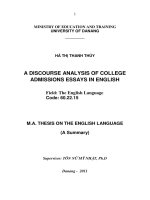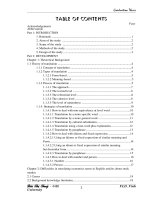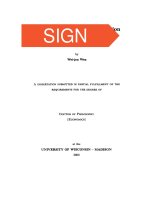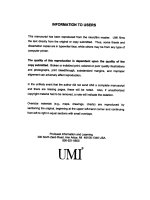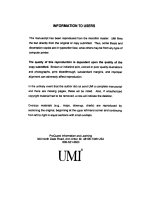essays in labor economics
Bạn đang xem bản rút gọn của tài liệu. Xem và tải ngay bản đầy đủ của tài liệu tại đây (1.06 MB, 263 trang )
NORTHWESTERN UNIVERSITY
Essays in Labor Economics
A DISSERTATION
SUBMITTED TO THE GRADUATE SCHOOL
IN PARTIAL FULFILLMENT OF THE REQUIREMENTS
for the degree
DOCTOR OF PHILOSOPHY
Field of Economics
By
Basit Zafar
EVANSTON, ILLINOIS
June 2008
UMI Number: 3303622
3303622
2008
Copyright 2008 by
Zafar, Basit
UMI Microform
Copyright
All rights reserved. This microform edition is protected against
unauthorized copying under Title 17, United States Code.
ProQuest Information and Learning Company
300 North Zeeb Road
P.O. Box 1346
Ann Arbor, MI 48106-1346
All rights reserved.
by ProQuest Information and Learning Company.
2
c
Copyright by Basit Zafar 2008
All Rights Reserved
3
Table of Contents
List of Tables 6
List of Figures 9
ABSTRACT 10
Acknowledgements 12
Chapter 1. Introduction 14
Chapter 2. College Major Choice and the Gender Gap 19
2.1. Introduction 19
2.2. Choice Model 26
2.3. Data 28
2.4. Econometric Model 47
2.5. Single Major Choice Mo del 50
2.6. Double Major Choice Model 70
2.7. Understanding Gender Di¤erences 78
2.8. Conclusion 85
Chapter 3. Social Conformity: Theory and Experimental Investigation 89
3.1. Introduction 89
3.2. Literature Review 92
4
3.3. Model of Charity Contribution 96
3.4. Experiment 105
3.5. Empirical Analysis 111
3.6. Conclusion 126
Chapter 4. College Major Choice: Revisions to Expectations, Perceptions of
Discrimination, and Experimentation 129
4.1. Introduction 129
4.2. Data 133
4.3. Beliefs of Discrimination 140
4.4. Updating Beliefs 150
4.5. Experimentation with majors 161
4.6. Conclusion 162
References 166
Appendix A. Appendix 1 for Chapter 2 177
A.1. Survey Questions 177
A.2. Debrie…ng 181
A.3. Figures and Tables 187
Appendix B. Appendix 2 for Chapter 2 203
B.1. Tables for Choice Model Estimation 203
Appendix C. Appendix for Chapter 3 220
C.1. Experimental Instructions 220
5
C.2. Marlowe-Crowne 2(10) Social Desirability Scale 224
C.3. Debrie…ng 225
C.4. Mathematical Appendix 227
C.5. Figures and Tables 234
Appendix D. Appendix for Chapter 4 241
D.1. Selective Comments 241
D.2. Figures and Tables 243
6
List of Tables
A.1 List of Majors 190
A.2 Sample Characteristics 191
A.3 Distribution of WCAS Majors 192
A.4 Percent Chance of graduating with a GPA of at least 3.5 if majoring
in: 193
A.5 Percent Chance of reconciling work and family at the jobs if majoring
in: 194
A.6 Statistics on Average Annual Starting Salaries of 2006 Graduates 195
A.7 Explaining the errors in students’salary expectations 196
A.8 Expected Annual Salary at the Age of 30 198
A.9 Percentage Chance of being active in the full-time labor force 199
A.10 Best Linear Predictor of Expectations of being active in the labor
force 200
A.11 Correlation Patterns between respondent’s and parents’majors
(Frequency in cell) 202
B.1 Single Major Choice- Estimation of Homogeneous Preferences 204
B.2 Decomposition Analysis 205
7
B.3 Thought Experiments 206
B.4 Estimation of heterogeneous preferences using Stated Preference 207
B.5 Decomposition Analysis 209
B.6 Best Linear Predictor of Expectation of Parent’s Approval 210
B.7 Mixed Logit Model Estimation 212
B.8 Decomposition Analysis for double major respondents using stated
preference data 213
B.9 Distribution of Double Majors 214
B.10 Double Major Choice Model - Estimation Using Choice Data 215
B.11 Contributions of various outcomes 216
B.12 Double Major Choice Model with Error Components 217
B.13 Decomposition Analysis to explain gender di¤erences 218
B.14 Simulations of the Gender Gap under di¤erent Environments 219
C.1 Donation Statistics 235
C.2 Wilcoxon Rank Sum Test 236
C.3 Contribution response to group choice in Round 2 236
C.4 Contribution response to group choice in Round 3 237
C.5 Contribution response to group choice in Rd. 3 238
C.6 Contributions and the Group Choice 238
C.7 Explaining the Change in contributions in Rounds 4-6 239
8
C.8 Responding to friends and strangers 240
D.1 Sample Characteristics 246
D.2 Statistics on Average Annual Starting Salaries of Northwestern 2007
Graduates 247
D.3 Explaining the errors in students’salary expectations 248
D.4 Summary Stats about labor force participation, fertility beliefs and
time use 250
D.5 Best Linear Predictor of Expectations of being active in the full-time
labor force at 30 251
D.6 Best Linear Predictor of Expectations of being active in the full-time
labor force at 40 252
D.7 Perceptions of Monetary and Non-Monetary Discrimination 253
D.8 Reasons for gender di¤erences in income within majors 254
D.9 Correlation patterns between various beliefs 255
D.10 Single Major Choice- Estimation of Preferences 256
D.11 Decomposition Analysis 257
D.12 Stated reasons for cho osing a major 258
D.13 The change in beliefs over time 259
D.14 The nature of evolution of beliefs over time 260
D.15 Patterns in experimentation with majors 261
D.16 Summary Statistics for experimentation with majors 262
9
List of Figures
A.1 Gender Composition of Undergrad Majors of 1999-2000 Bachelor’s
Degree Recipients Employed Full-Time in 2001. 187
A.2 Average income of 1999-2000 Bachelor’s Degree Recipients Employed
Full-Time in 2001 by Undergraduate Major. 188
A.3 Timeline 189
C.1 Cumulative Density of Contributions 234
D.1 Timeline of the surveys 244
D.2 Change in the GPA beliefs in response to change in GPA realized
between the surveys. 244
D.3 Change in GPA beliefs in response to new information revealed
between the two surveys. 245
10
ABSTRACT
Essays in Labor Economics
Basit Zafar
This dissertation analyzes how individuals choose college majors. The choice of col-
lege major is treated as one made under uncertainty. Understanding any decision under
uncertainty requires one to study how expectations and preferences are used to make the
choice. However, since observed choices may be consistent with many combinations of
expectations and preferences, I instead collect a unique panel dataset of Northwestern
students which contains their subjective expectations about choice-speci…c outcomes.
Chapter 2 estimates the decision rule of college major choice by combining subjective
expectations with choice data. I obtain three main results: (1) non-pecuniary outcomes
explain nearly half of the choice, (2) males and females are similar in their preferences for
outcomes in college but di¤er in their preferences for outcomes in the workplace, and (3)
the gender gap in major choice is mainly because of gender di¤erences in beliefs about
enjoying studying di¤erent majors, and gender di¤erences in preferences.
Chapter 3, motivated by the fact that there is a positive correlation between one’s own
major and that of their parents and elder siblings, outlines a model in which conformity
11
in actions may arise from learning about the norm, or from image-related concerns (social
in‡uence). To empirically disentangle the two, I use the fact that image-related concerns
can only be present if actions are publicly observable. The model predictions are tested
in a charitable contribution experiment in which the actions and identities of the subjects
are unmasked in a controlled and systematic way. Both learning and social in‡uence seem
to play an important role in the choices of the subjects.
Chapter 4 focuses on how individuals revise expectations, and analyzes perceptions of
discrimination associated with major choice. Changes in expectations are found to vary
in sensible ways. Priors for outcomes realized in college are found to be fairly precise,
while students seem to gain valuable information about outcomes that are realized in the
workplace. Perceptions of being treated poorly in the jobs in the various majors are found
to be negatively correlated with the fraction of one’s own gender in that …eld of study.
12
Acknowledgements
I would like to thank members of my dissertation committee, Charles Manski, Paola
Sapienza, and Christopher Taber for their invaluable guidance and continuous support.
I am particularly grateful to Charles Manski for being an outstanding advisor. I am
also grateful to Raquel Bernal, Hilarie Lieb, and participants of the Northwestern Labor
Lunches for their insightful comments and suggestions. I would like to thank all those
involved in providing the datasets used in this dissertation. I also want to thank all the
people who made my PhD years in Evanston a joyful adventure, and in particular Joyee
Deb, Aniruddha Gupta, Piyush Jain, Siddarth Madhav, Zahra Siddique, and Amir Toft.
Financial support for my dissertation was provided in part by the Graduate Research
Grant, Eisner Fund, and Ronald Braeutigam.
Above all, I wish to thank my parents, Nargis Perveen and Zafar Iqbal, for their
constant care, love and encouragement over the years. They’ve always been there for me
when I needed them, and have been fully supportive of my choices. Finally, I wish to
thank my wife, Samina. She followed me on this voyage, lived through its ups and downs,
and kept me a‡oat through my hard times. I dedicate this dissertation to my family- I
feel they share a large part of my achievements and that I could not have done it alone.
13
To my family
14
CHAPTER 1
Introduction
Choosing a college major is a decision that has signi…cant so cial and economic con-
sequences. However, little is known about how youth choose college majors. A second
intriguing point in the context of college majors is the empirical fact that males and
females choose very di¤erent majors. For example, in 1999-2000 in the United States,
while nearly three-quarters of the recipients of Education bachelor’s degrees were females,
less than one-…fth of Engineering bachelor’s degree recipients were females (Dey and Hill,
2007). The …rst part of this dissertation focuses on the question of how undergraduates
choose college majors, and attempts to explain why males and females make di¤erent
choices with regards to college majors.
I treat the choice of college major as one made under uncertainty- uncertainty about
personal tastes, individual abilities, and realization of outcomes related to choice of major.
Understanding any decision under uncertainty requires one to study how expectations
and preferences are used to make the choice. The approach prevalent in the literature
is to make non-veri…able assumptions on expectations, and employ choice data to infer
preferences. However, this can be problematic since observed choices may be consistent
with many combinations of expectations and preferences (Manski, 1993a). In order to
overcome this identi…cation problem, I collect additional data on expectations to estimate
a choice model of college majors. The study was conducted at Northwestern in Fall 2006
15
and Fall 2007; the dataset contains students’subjective expectations about choice-speci…c
outcomes, and data on their demographics and background information.
In Chapter 2, I estimate a random utility model of college major choice allowing for
heterogeneity in beliefs and controlling for both the pecuniary and non-pecunairy deter-
minants of the choice. Prior to this work, there has been virtually no empirical analysis
of the non-pecuniary determinants of the choice of college majors. This gap in the liter-
ature primarily stems from a lack of detailed data on the non-pecuniary outcomes of the
choice. I …nd that non-pecuniary outcomes are signi…cant in the choice. Enjoying course-
work, enjoying work at potential jobs, and approval of parents are the most important
determinants in the choice of college major. Males and females have similar preferences
while in college, but di¤er in their preferences in the workplace; males care more about
pecuniary aspects (social status of the jobs, future income) while females care more about
the non-pecunairy aspects of the workplace (enjoying working at the jobs, reconciling
work and family). The second half of chapter 2 focuses on the underlying reasons for
the gender gap in the choice of majors. At least two di¤erent explanations have been
put forward in the literature for this gender gap: (1) innate di¤erences between males
and females (Kimura, 1999; Baron-Cohen, 2003), and (2) gender-based discrimination
(Valian, 1998). The structural approach that I adopt in the paper allows me to check
the validity of these hypotheses. I decompose the gender gap into di¤erences in beliefs
and preferences. First, I …nd that gender di¤erences in beliefs about academic ability and
expected income constitute a small and insigni…cant part of the gap; this allows me to
rule out hypotheses like women being low in self-con…dence relative to men (Niederle et
al., 2007), and monetary discrimination in the workplace as possible explanations for the
16
gender gap. Conversely, I …nd that most of the gender gap is due to di¤erences in beliefs
about enjoying coursework, and gender di¤erences in preferences.
Chapter 2 does not focus on the aspect that individuals may …nd it optimal to ex-
periment with di¤erent majors to learn about their ability and match quality (Manski,
1989; Altonji, 1993; Malamud, 2006). This is one of the issues explored in Chapter 4.
More speci…cally, this chapter tries to address three questions: (1) why and how individ-
uals revise their expectations for the various major-speci…c outcomes, (2) why females,
relative to males, enjoy studying …elds like engineering and sciences less, and (2) why
individuals experiment with di¤erent majors. For this purpose, the students who were
surveyed for chapter 2 were re-surveyed. I …nd that changes in expectations about vari-
ous major-speci…c outcomes vary in sensible ways. Moreover, priors for outcomes that are
realized in college (like approval of parents, graduating in 4 years) are fairly precise, while
individuals seem to gain valuable information between the two surveys about outcomes
that are realized in the workplace. Though individuals seem to be aware of a wage gap in
favor of males in most majors, they underestimate the extent of the gap, and incorrectly
believe that the wage gap stays roughly constant over time. Moreover, males and females
di¤er in their reasons for the wage gap- while males believe it to be because of innate
di¤erences between the two genders, females believe it is because employers expect the
two genders to have di¤erent characteristics. Perceptions of being treated poorly in the
jobs in the various majors are found to be negatively correlated with the fraction of the
people of one’s own gender in the …eld of study, the wage gap, and beliefs of enjoying the
coursework and working at the jobs. Finally, I …nd that academic performance is not the
only consideration with regards to experimentation with majors.
17
On the methodology side, both chapters 2 and 4 add to the recent literature on subjec-
tive expectations (Manski, 2004). Chapter 2 contributes to this literature by providing an
extensive description of students’expectations about major-speci…c outcomes, by using
subjective expectations data to estimate a choice model, and by explaining the mecha-
nisms through which beliefs form. Chapter 4 adds to the few studies in this literature
that have looked at how individuals form and revise subjective expectations in response
to new information. The panel on subjective beliefs allows me to answer several doubts
that have been raised about the validity of subjective expectations data (Bertrand and
Marianne, 2001). The results in chapter 4 bode well for the use of subjective expectations.
The analysis in chapter 3 is motivated by the …nding in chapter 2 that individuals’
college major choices are correlated with those of their parents and elder siblings. However,
a positive correlation between an individual’s choice of college major with that of his
reference group is consistent with either the individual (1) learning about that particular
choice through the experiences of others, and hence choosing that major (social learning),
(2) getting a utility gain by simply having the same major as that of one’s reference
group (social comparison), or (3) sticking to the norm because of image-related concerns
(social in‡uence). Unfortunately, I cannot disentangle these mechanisms in my data.
Moreover, though social interactions have been an active area of economic research for
some time now, most studies focus on measuring the extent of social interactions and
very little attention has been given to studying the mechanisms through which they are
generated; this is primarily because of the various identi…cation challenges that one faces
when measuring social interactions (Manski, 1993, 2000). I tackle this issue in chapter 3
which outlines a simple model constructed on the premise that people are motivated by
18
their own payo¤ and by how their action compares to others in their reference group. I
show that conformity in actions may arise from learning about the norm (social learning
or comparison concerns), or from image-related concerns (social in‡uence). In order to
empirically disentangle the two, I use the fact that image-related concerns can only be
present if actions are publicly observable. The model predictions are tested in a charitable
contribution experiment in which the actions and identities of the subjects are unmasked
in a controlled and systematic way. The experimental setting provides an environment
that provides clean evidence on each of these mechanisms, and also allows me to overcome
the di¢ cult identi…cation problems in measuring social interactions in real world settings.
I …nd that both learning about the norm and social in‡uence play an important role in
the choices of the subjects. Individuals indulge in social comparison and change their
contributions in the direction of the social norm even when their identities are hidden.
Once identities and contribution distributions of group members are revealed, individuals
conform to the modal choice of the group. Moreover, social ties (de…ned as subjects
knowing each other from outside the lab) a¤ect the role of social in‡uence. In particular,
a low contribution norm evolves that causes individuals to contribute less in the presence
of friends.
19
CHAPTER 2
College Major Choice and the Gender Gap
2.1. Introduction
The di¤erence in choice of college majors between males and females is quite dra-
matic. In 1999-2000, amongst recipients of bachelor’s degrees in the US, 13 percent of
women majored in education compared to 4 percent of men, and only 2 percent of women
majored in engineering compared to 12 percent of men (2001 Baccalaureate and Beyond
Longitudinal Study). Figure A.1 highlights the di¤erences in gender composition of un-
dergraduate majors of 1999-2000 bachelor’s degree recipients (see also Polacheck, 1978;
Turner and Bowen, 1999; Dey and Hill, 2007).
These markedly di¤erent choices in college major between males and females have
signi…cant economic and social impact. Figure A.2 shows that large earnings premiums
exist across majors. For example, in 2000-2001, a year after graduation in the US, the
average education major employed full-time earned only 60 percent as much as one who
majored in engineering (also see Eide and Grogger, 1995; Garman and Loury, 1995; Ar-
cidiacono, 2004, for a discussion of earnings di¤erences across majors). Paglin and Rufolo
(1990), and Brown and Corcoran (1997) …nd that di¤erences in major account for a sub-
stantial part of the gender gap in the earnings of individuals with several years of college
education. Moreover, Xie and Shauman (2003) show that, controlling for major, the gap
between men and women in their likelihood of pursuing graduate degrees and careers in
20
science and engineering is smaller. The gender di¤erences in choice of major have recently
been at the center of hot debate on the reasons behind women’s under-representation in
science and engineering (Barres, 2006).
There are at least two plausible explanations for these di¤erences. First, innately dis-
parate abilities between males and females may predispose each group to cho ose di¤erent
…elds (Kimura, 1999, and 2006). However, studies of mathematically gifted individuals
reveal di¤erences in choices across gender, even for very talented individuals. For exam-
ple, the Study of Mathematically Precocious Youth shows that mathematically talented
women preferred careers in law, medicine, and biology over careers in physical sciences
and engineering (Lubinski and Benbow, 1992). Moreover, the gender gap in mathemat-
ics achievement and aptitude is small and declining (Xie and Shauman, 2003; Goldin et
al., 2006), and gender di¤erences in mathematical achievement cannot explain the higher
relative likelihood of majoring in sciences and engineering for males (Turner and Bowen,
1999; Xie and Shauman, 2003). These studies suggest gender di¤erences in preferences
as a second possible explanation for the gender gap in the choice of major. However, no
systematic attempt has been made to study these preferences.
In this paper, I estimate a choice model of college major in order to understand how
undergraduates choose college majors, and to explain the underlying gender di¤erences.
The choice of major is treated as a decision made under uncertainty–uncertainty about
personal tastes, individual abilities, and realizations of outcomes related to choice of
major. Such outcomes may include the associated economic returns and lifestyle as well
as the successful completion of major. My choice model is closest in spirit to the theoretical
model outlined in Altonji (1993), which treats education as a sequential choice made under
21
uncertainty. In his dynamic model, the decision about attending college, …eld to major in,
and dropping out are based on uncertain economic returns, personal tastes, and abilities.
I, however, do not model the choice of college. The particular institutional setup in the
Weinberg College of Arts & Sciences (WCAS) at Northwestern allows me to estimate a
choice model of college major where the decision can be treated as dynamic. However,
since individuals are assumed to maximize current expected utility, a static choice model
is estimated in this paper.
The standard economic literature on decisions made under uncertainty generally as-
sumes that individuals, after comparing the expected outcomes from various choices,
choose the option that maximizes their expected utility. Given the choice data, the goal
is to infer the decision rule. However, the expectations of the individual about the choice-
speci…c outcomes are also unknown. The approach prevalent in the literature overlooks
the fact that subjective expectations may be di¤erent from objective probabilities, as-
sumes that formation of expectations is homogeneous, makes non-veri…able assumptions
on expectations, and uses choice data to infer decision rules conditional on maintained
assumptions on expectations. However, this can be problematic since observed choices
might be consistent with several combinations of expectations and preferences, and the
list of underlying assumptions may not be valid (see Manski, 1993a, for a discussion of this
inference problem in the context of how youth infer returns to schooling). To illustrate
this, let us assume that only two majors exist. Let us assume further that it is easier to
get a college degree in the …rst major, but that it o¤ers lower-paying jobs than the second
major. An individual choosing the …rst major is consistent with two underlying states of
the world: (1) she only cares about getting a college degree, or (2) she only values the job
22
prospects but believes that the …rst major will get her a high-paying job. If one observes
only the choice, then clearly one cannot discriminate between the two possibilities. The
solution to this identi…cation problem is to use additional data on expectations since it
allows the researcher to separate the two possibilities, and that is precisely what I do.
I have designed and conducted a survey to elicit subjective expectations from 161
Northwestern sophomores regarding choice of major. The survey collects data on de-
mographics and background information, data relevant for the estimation of the choice
model, and open-ended responses intended to explore how individuals form expectations.
In contrast to most studies on schooling choices which ignore uncertainty, I estimate
a random utility model of college major choice allowing for heterogeneity in beliefs.
1
My
approach also di¤ers from the existing literature by accounting for the non-pecuniary
aspects of the choice. Fiorito and Dau¤enbach (1982) and Easterlin (1995) highlight
the importance of non-price determinants in the choice of majors. However, no study
has jointly modeled the pecuniary and non-p ecuniary determinants of the choice. My
approach allows me to quantify the contributions of both pecuniary and non-pecuniary
outcomes to the choice. Moreover, the model is rich enough to explain gender di¤erences
in choices.
Responses to questions eliciting subjective expectations match up with existing statis-
tics for several questions indicating that respondents answer meaningfully and seriously.
Respondents exhibit signi…cant heterogeneity in their responses (both between and within
1
Literature on college majors has largely ignored the uncertainty associated with the various ou tcomes of
the choice. Two notable empirical exceptions are Bamberger (1986), and Arcidiacono (2004). However,
the former only takes into account the uncertainty about completing one’s …eld of study. The latter
estimates a dynamic model of college and major choice under highly stylized assumptions on expectations
formation.
23
genders), which underscores the importance of expectations data to conduct inference in
settings with uncertainty. For example, the mean belief of being active in the full-time
labor force at the age of 30 is 87.23% for females, and 95.11% for males. The gap widens
for beliefs of labor force participation at the age of 40. Di¤erences in beliefs could arise
if people’s experiences di¤er and beliefs are formed as a consequence of the individual’s
experiences and interactions with others in society. Other than that, beliefs could be
shaped intentionally either by the subconscious, or by one’s parents and peers. I …nd
strong evidence of the latter- parents play a crucial role in shaping one’s beliefs. More-
over, the e¤ect di¤ers by gender. For example, females with a stay-at-home mother have
beliefs of being active in the full-time labor force at the age of 40 that are, on average,
12 points lower (on a 0-100 scale) than females with a working mother; no corresponding
e¤ect is found for males.
I estimate separate models for single major choice and for double major choice. The
most important outcomes in the choice of single major are enjoying coursework, enjoy-
ing work at potential jobs, and approval of parents. Non-pecuniary outcomes explain
about 45% of the choice behavior for males, and more than three-fourths of the choice
for females. Males and females have similar preferences at college, but di¤er in their
preferences regarding the workplace: males care more about the pecuniary outcomes in
the workplace, females about the non-pecuniary outcomes. The results for the double
major choice model are similar to those for single major. Graduating in 4 years, approval
of parents, and enjoying coursework are the most important determinants of the choice.
Additionally, I …nd evidence of individuals strategically choosing pairs of majors that
allow them to specialize along certain dimensions. Females prefer pairs of majors which
24
entail di¤erent chances of completion and getting a job up on graduation. On the other
hand, males prefer major pairs that di¤er in their chances of completion, in the approval
of parents, and in how much they would enjoy the coursework.
Besides being related to the literature on college major choice, this paper is related
to three strands of literature. On the methodology side, it adds to the recent literature
on subjective expectations (see Manski, 2004, for an overview of this literature). In the
last decade or so, economists have increasingly undertaken the task of collecting and
describing subjective data. Recently expectations data have been employed to estimate
decision models. Van der Klaauw (2000) uses expectations data to improve the precision of
the parameter estimates of a dynamic model of teacher career decisions. Delavande (2004)
collects subjective data to estimate a choice model of birth control choice for women. The
choice model used in this paper is motivated by her framework. The most recent step in
this literature studies the formation of beliefs (Di Tella et al., 2007; and Lochner, 2007).
My paper contributes to all three branches of this literature by providing an extensive
description of students’expectations about major-speci…c outcomes, by using subjective
expectations data to estimate a choice model, and by explaining the mechanisms through
which beliefs form.
Second, this paper contributes to the recent literature on culture and economic out-
comes (see Guiso et al., 2006; Alesina and Giuliano, 2007; Fernandez, 2007a). In order
to establish a causal link from culture to economic outcomes, I focus on the dimension
of culture that is inherited by an individual from previous generations, rather than being
voluntarily selected. I use information on the country of origin of the individual’s parents
as a cultural proxy. Cultural proxies are found to bias beliefs in systematic ways, and the
